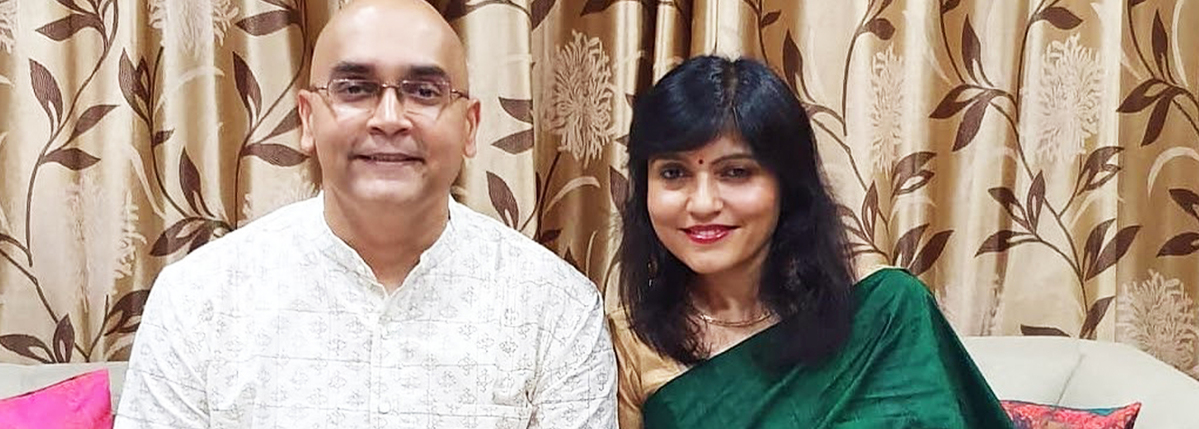After Years of Denial, This Man Manages His Diabetes with Insulin
When Arvind Ramaswamy was diagnosed with MODY 1 diabetes—a rare and genetic form of diabetes that differs from both type 1 or type 2—at 20 years old in 1995, he was convinced the doctors had made a mistake. After ignoring symptoms for over a year, a poorly healing injury led his doctor to check his blood sugar.
Despite a result of 300 mg/dL, Arvind says he didn’t take it seriously.
“I told myself the results were wrong,” recalls Arvind. “So I changed doctors and never told my new healthcare team about it.”
Today, Arvind is 46 years old and lives near Mumbai in India. While his career as a software architect has evolved within the healthcare industry, he says it wasn’t until his colleagues urged him to see a doctor in 2001 that he truly faced his diagnosis.
“I was falling asleep on my desk,” he remembers. “People were mocking me for being lazy, and I really started hating myself for being so lazy, too. I didn’t realize my symptoms were due to diabetes.”
Arvind’s most memorable symptoms include feeling constantly hungry, intensely thirsty, severely tired and craving food even after eating.
After a colleague drove him to the hospital one afternoon, he discovered his blood sugar was up to 500 mg/dL.
The next day, he had an appointment with an endocrinologist where a C-peptide test showed his body was still producing a reasonable amount of insulin, and he clearly didn’t have type 1 diabetes. Further testing led to a MODY-1 diagnosis.
At work, his colleagues also started treating him better after learning why he’d been feeling so lethargic and struggling to keep up with his projects.
Depression. Anger. Denial.
Despite starting on sulfonylurea and metformin, which improved his blood sugars significantly, Arvind says he was overwhelmed with depression.
“I went into a depression because of the stigma and the feeling of this life sentence,” recalls Arvind. “At every doctor’s appointment, the waiting room was filled with elderly people, so I thought ‘why me?’ at such a young age.”
Prior to his own diagnosis, the only other young person Arvind had known with diabetes was a young girl in his neighborhood with type 1. She was diagnosed at 2 years old.
“Beyond her, I just felt like the only one. I thought diabetes was rare,” he says. “But no one can help you if you don’t have self-realization and face your diagnosis.
Eventually, Arvind’s doctor transitioned him off the sulfonylurea and started him on a DPP-4 inhibitor called sitagliptin (brand name, Januvia). He continued to take metformin.
Meanwhile, his anger and denial persisted.
Starting insulin after collapsing at work
In 2008, Arvind collapsed suddenly at work and found himself at the hospital again.
“I was working day and night, not eating properly and not taking my medications properly,” recalls Arvind, of his emergency hospitalization.
Results of another C-peptide test showed he was producing even less insulin than before, so his healthcare team started him on daily injections of long-acting insulin, Lantus.
“I was also diagnosed with retinopathy and neuropathy,” explains Arvind, who knows looking back that the years he spent in denial of his diabetes likely contributed significantly to the damage in his eyes and feet. “I’ve received five laser treatments so far for the bleeding in my eyes and it seems to be working.”
As for starting insulin, Arvind said the decision and daily task wasn’t hard for him.
“Both of my parents were taking insulin at that point for their diabetes, both diagnosed with type 2 around 60 years old,” he explains. “I used to give them their injections.”
Eventually, Arvind’s blood sugars proved that his body needed a rapid-acting insulin for meals in addition to this long-acting dose. Today, he takes Humalog with his meals and two daily injections of Lantus for his background insulin needs. He also takes Janumet—a combination of Januvia and metformin.
The woman who changed everything.
Later, in 2008, Arvind met a woman named Ruchika Kathuria in an online diabetes support group who’s lived with type 1 diabetes for most of her life.
“I’d actually left the support group a year before that, but in October of 2008, something told me I should rejoin.”
That very night, Ruchika reached out to him.
“She didn’t even have a picture in her profile,” says Arvind of his then future wife. “But I just knew.”
Very quickly after meeting, she began teaching Arvind about the importance of taking his medications every day, getting more exercise, preventing and managing complications and being more thoughtful about what he eats.
Today, Ruchika is a CDCES and volunteers regularly for the Blue Circle Foundation, helping other people with diabetes deal with depression.
“My wife takes such good care of my diet and helps me take my medications on time,” says Arvind. “She never tires. She is very disciplined with her food and medications. She does get frustrated with my habits sometimes, but she never gives up on me.”
Despite Ruchika’s encouragement, Arvind says he’s naturally very reluctant to eat healthier things like vegetables and salads.
“I ate a very low-carb diet for about six months and my A1c came down to 7.1 percent,” he adds. “But I couldn’t maintain eating so few carbs. Food is still a big struggle for me. Today, my A1c is 8.3. Even if I try to take correction doses for highs or increase my long-acting, it doesn’t work because I’ve become so insulin resistant.”
One thing Arvind says does make a difference are his daily walks.
“I do walk a lot every day to help counter the insulin resistance,” he explains. “And even if I miss a week of walking, I see my blood sugars start rising.”
If you’re struggling with denial…
“My advice for those struggling with denial like I was? We need to be realistic,” says Arvind.
“The longer you deny it, the more damage your body is going to experience. We just have to be grateful that we’ve been diagnosed and do what we can to prevent complications. I’ve paid a hefty price with complications for my denial.”
Educational content related to medications for type 2 diabetes is made possible with support from Lilly Diabetes. Beyond Type 2 maintains full editorial control of all content published on our platforms.





